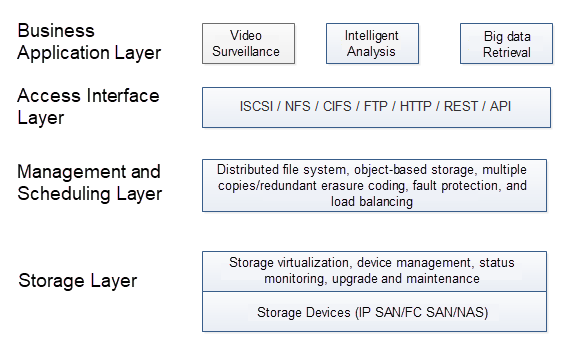Cloud storage is an online storage mode that stores data on multiple virtual servers hosted by a third party instead of dedicated servers. Hosting companies operate large data centers. People that need data storage hosting meet their needs by purchasing or leasing storage space from these companies. Data center operators prepare storage virtualization resources at the backend according to customers’ needs and provide resources in the form of the storage pool. By doing so, customers can use this storage pool to store files or objects. These resources may be distributed on many server hosts.
As a core component of cloud computing, cloud storage undertakes the task of data storage at the bottom layer of data. It is the foundation of the entire cloud platform and cloud services. Compared with traditional storage devices, it cannot be understood simply as a single hardware device. This device can also be understood as a system, which generally consists of a hardware environment, including servers, storage, network, and related software.
Similar to cloud computing, cloud storage refers to a system in which a large number of different types of storage devices in a network work together through a collection of application software to provide data storage and business access to the outside world through functions, such as cluster applications, grid technology, or distributed file systems. Therefore, data security can be ensured, and storage space can be saved as well. Simply put, cloud storage is an emerging solution for putting storage resources on the cloud for user access. Users can connect to the cloud through any network device to access data easily anytime and anywhere.

The storage layer is the foundation of cloud storage. Cloud storage connects different storage devices to form a service-oriented distributed storage system. On top of physical storage devices, this is a unified storage device management layer that enables logical virtualization management, status monitoring, and maintenance of physical storage devices.
The management and scheduling layer is the core of cloud storage. It is used to deploy distributed file systems or create and organize storage resource objects on the storage resources provided by the storage layer. It also shards user data and stores the data to specific storage resources with multiple copies or redundant erasure coding according to the protection policy. Meanwhile, this layer performs tasks, such as read/write load balancing among nodes, business scheduling, and data reconstruction and recovery after nodes or storage resources fail, to ensure high performance and highly available access services. However, in the practices, functions of this layer may also be moved up, located between the access interface layer and the application service layer, or directly embedded in the application service layer. It is closely integrated with business applications to form business-specific cloud storage.
The access interface layer is a freely scalable, user-oriented structural layer. In general, according to the specific situation and needs, it opens a variety of interfaces to provide a variety of services.
The user access layer is available on any machine connected to the Internet, as long as the user is authorized to access the cloud storage platform system. In this layer, users perform the permitted authorized operations on the cloud storage and enjoy various services brought by cloud storage.
Disclaimer: The views expressed herein are for reference only and don't necessarily represent the official views of Alibaba Cloud.
Purchasing an Affordable Virtual Private Server for Your Web Apps: An Intro to Light Space
An Introduction to Alibaba Cloud: A Whitepaper on What Is Alibaba Cloud All About

873 posts | 198 followers
FollowAlibaba Clouder - November 11, 2020
Hologres - December 2, 2022
Alibaba Developer - January 5, 2022
Alibaba Clouder - July 16, 2020
Alibaba F(x) Team - February 23, 2021
Alibaba EMR - May 20, 2022

873 posts | 198 followers
Follow Storage Capacity Unit
Storage Capacity Unit
Plan and optimize your storage budget with flexible storage services
Learn More Data Lake Storage Solution
Data Lake Storage Solution
Build a Data Lake with Alibaba Cloud Object Storage Service (OSS) with 99.9999999999% (12 9s) availability, 99.995% SLA, and high scalability
Learn More Hybrid Cloud Storage
Hybrid Cloud Storage
A cost-effective, efficient and easy-to-manage hybrid cloud storage solution.
Learn More Quick Starts
Quick Starts
Deploy custom Alibaba Cloud solutions for business-critical scenarios with Quick Start templates.
Learn MoreMore Posts by Alibaba Cloud Community